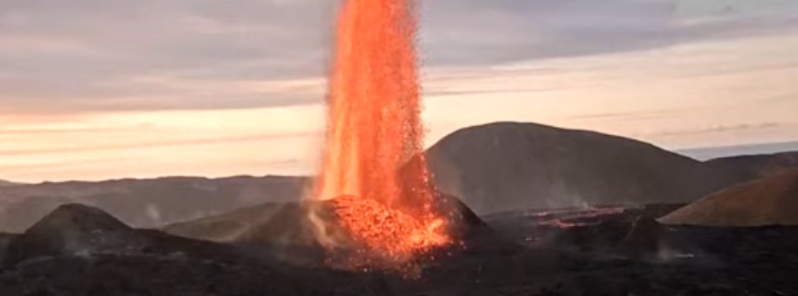Unusually high lava fountains beyond 460 m (1 500 feet) at Fagradalsfjall, Iceland

Powerful jets of lava have been observed at the Fagradalsfjall eruption site on Iceland's Reykjanes Peninsula, with some reaching unusual heights beyond 460 m (1 500 feet) at 05:40 UTC on Wednesday, May 5, 2021, the Icelandic Met Office (IMO) reported.
On Wednesday, IMO noted a slight change in the seismic tremor measurements at Fagradalsfjall shortly before 04:30 UTC.
Until then, the rhythm had been the same, roughly 10 minutes between magma jets. However, in the morning, about half an hour passed between powerful magma jet eruptions.
At 05:40 UTC, IMO reported an "unusually high magma jet" that went beyond the perspective on the RUV webcam and "seems to have risen above 460 m (1 500 feet)."
Due to the powerful lava fountains and materials ejected from a great distance, authorities defined new danger zones. Incandescent materials were spewed southwest of the crater, starting a fire and emitting smoke.
The activity on the volcano is characterized by intermittent episodes of pulsating lava fountains from the central vent, following periods of calm effusion of lava.
Early this morning at #fagradalsfjall #Geldingadalir #iceland with lava fountains surpassing 400m @RUVfrettir @Vedurstofan for the livestream pic.twitter.com/9FGvpuPspa
— Volc-Han-ology (@han_volcan) May 6, 2021
Continúa la erupción volcánica en #Fagradalsfjall, Islandia.
Ayer la fuente de lava alcanzó los 400m de altura!
Via https://t.co/mtam6487KO pic.twitter.com/wvF9L91bFG— IGEO (CSIC-UCM) (@IGeociencias) May 6, 2021
#Iceland – #Fagradalsfjall volcano eruption continues.
Halldor Kolbeins #AFP pic.twitter.com/SdxpZzSu3I— AFP Photo (@AFPphoto) May 5, 2021
If you can’t stand the heat stay out of the crater! @DJIGlobal @BBCWorld @nytimes #willsmithtoiceland pic.twitter.com/Gvnf4mRzSn
— Bjorn Steinbekk (@BSteinbekk) May 5, 2021
Meanwhile back in #Iceland… some #Fagradalsfjall #volcano webcam stills. #Geldingaldalir #Reykjanes #geology pic.twitter.com/UEX4vmkTxp
— Ian Kluft (@ikluft) May 6, 2021
Geological summary
The Krýsuvík-Trölladyngja volcanic system is described by the Catalogue of Icelandic Volcanoes as an approximately 50 km (31 miles) long composite fissure swarm trending about N38°E, including a 30 km (18 miles) long swarm of fissures, with no central volcano.
It is one of the volcanic systems arranged en-echelon along the Reykjanes Peninsula west of Kleifarvatn lake.
The Fagradalsfjall and Krýsuvík fissure swarms are considered splits or secondary swarms of the Krýsuvík–Trölladyngja volcanic system.
Small shield volcanoes have produced a large portion of the erupted volume within the system.
Several eruptions have taken place since the settlement of Iceland, including the eruption of a large basaltic lava flow from the Ogmundargigar crater row around the 12th century.
The latest eruption, identified through tephrochronology, took place during the 14th century.
Featured image credit: RUV

Spectacular lava fountains reaching a height of 460m!